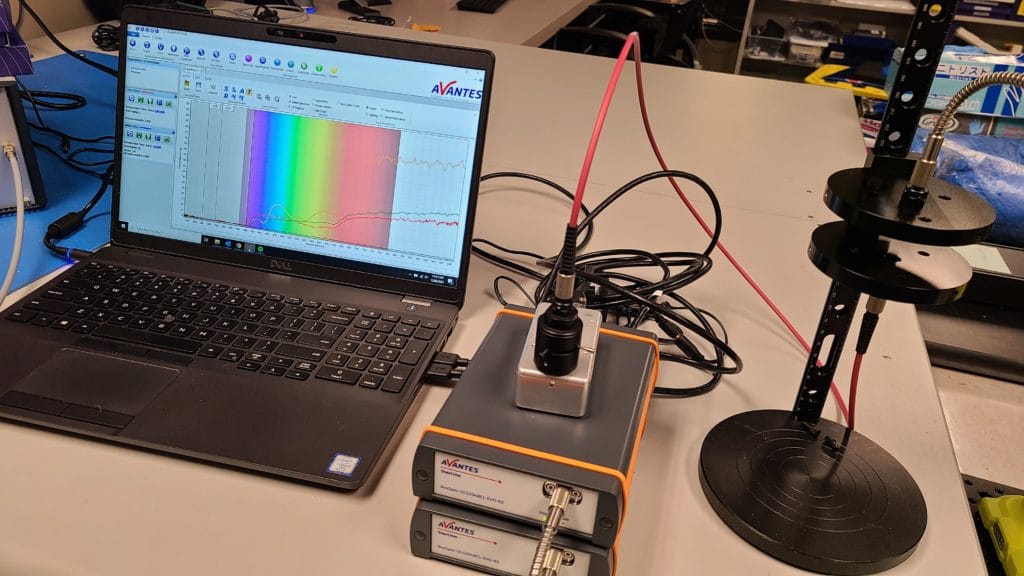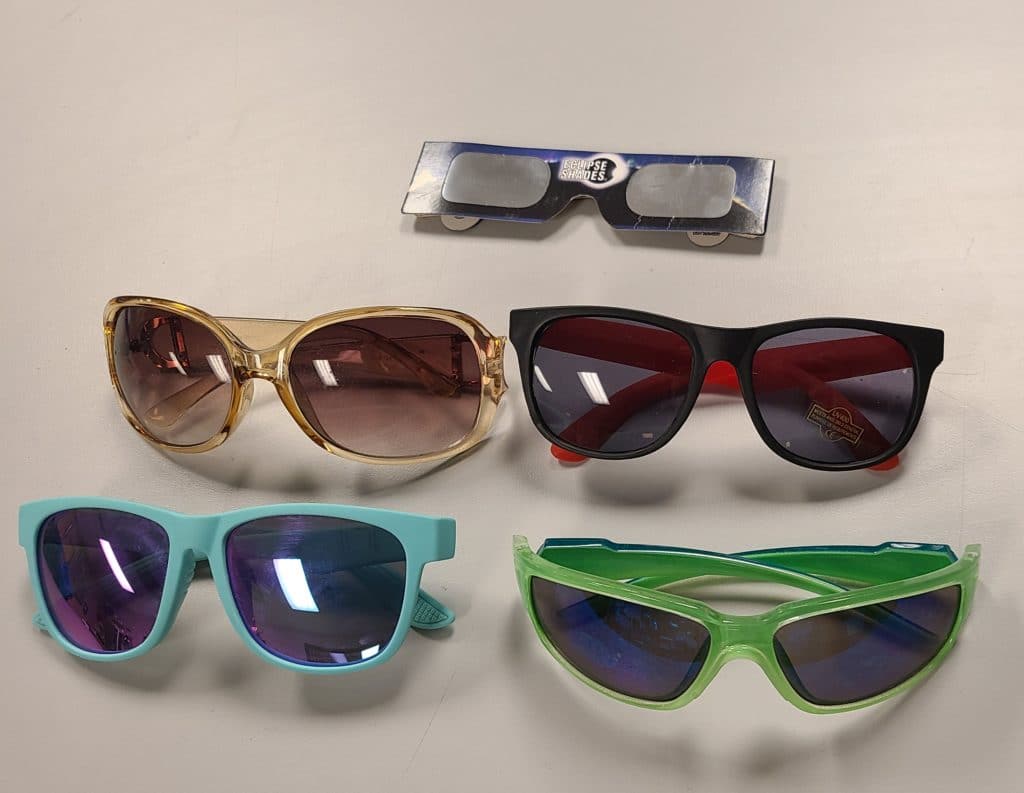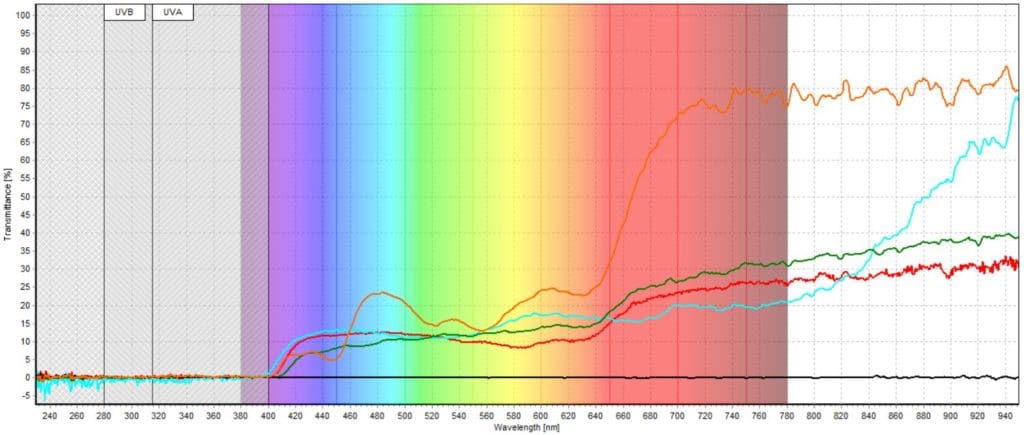UV Transmission of Sunglasses
Transmission spectra can be used in a wide range of measurements and data collection to reveal unique and unknown properties of materials. It is crucial to understand how materials that we interact with behave when exposed to photons across the UV/VIS/NIR spectrum. One excellent example of this is sunglasses. It is important to know if the glasses are blocking UV light from damaging your eyes.
Conducted by: David Ademe, Avantes Inc.
Application Background
The most common forms of UV light are UVA and UVB. Your eyes may take in a significant amount of UVB light without harming the retina, in general. UVA light, on the other hand, can infiltrate the eye more, which may cause additional problems. The sun has a higher amount of UVA versus UVB, but it’s essential to protect your eyes from both. If your eyes are exposed to excessive amounts of UV radiation over a short period of time, you will likely experience photokeratitis. Like a “sunburn of the eye,” photokeratitis can be painful. Its symptoms include red eyes, a foreign body sensation or gritty feeling in the eyes, extreme sensitivity to light and excessive tearing. Fortunately, these symptoms are usually temporary and rarely cause permanent damage to the eyes. The longer the eyes are exposed to solar radiation, the greater the risk of developing cataracts or macular degeneration later in life. Therefore, it is important to verify that the sunglasses you wear are indeed protecting your eyes from UV light.
To provide adequate protection for your eyes, sunglasses should:
- block out 99 to 100 percent of both UV-A and UV-B radiation;
- screen out 75 to 90 percent of visible light;
- have lenses that are perfectly matched in color and free of distortion and imperfection; and
- have lenses that are gray for proper color recognition.
Description of System:
For this experiment, we will be using a pulsed xenon light source as the AvaLight-XE-Mini provides a high intensity spectral output across the UV/VIS range. An attenuator will be attached to the front of the light source to give the user the ability to change the intensity of the source. Because xenon is such a powerful source, a small diameter core fiber is well fitted for the job. The fiber will couple the xenon light source to a collimating lens on the brand new Avantes Transmission/Reflection stage. The light will be focused onto the sample, which will then be received by a bifurcated fiber. This bifurcated fiber will feed the light to a dual channel setup of two AvaSpec-ULS2048CL-EVO spectrometers. Thanks to AvaSoft, it is possible to merge the spectrum of multiple spectrometers into a single spectrum. This allows the user to have multiple spectrometers configured optimally for different ranges. In this experiment, we will be using one spectrometer configured for the UV range and another configured for the visible range.
Using CMOS instead of the conventional CCD technology, this spectrometer is completely up to date and ready for the next decade. The dominant position of CCD detectors in the spectrometer field is fading and new technologies like CMOS have evolved and become a suitable alternative. The AvaSpec-ULS2048CL-EVO offers you this latest technology ensuring a spectrometer platform for the coming years. In combination with our latest AS-7010 electronics, the AvaSpec-ULS0248CL-EVO offers you a versatile device including USB3.0 communication with 10 times higher speed compared to USB2, and a second communication port which offers Gigabit Ethernet for integration in your company network and possibility for long distance communication, all at an affordable price. Besides the high-speed communication options, the EVO series spectrometers also offer a fast microprocessor and 50 times more memory capacity, which can help you to store more spectra onboard and realize more functionality. Options include a detector collection lens to enhance sensitivity in the 200-1100 nm range and order-sorting filter to reduce second-order effects. Furthermore, the AvaSpec-2048CL is available with a wide range of slit sizes, gratings and fiber-optic entrance connectors. It comes complete with AvaSoft-Basic software, USB cable and an extensive manual. The AvaSpec-ULS2048CL-EVO is also available as OEM unit, bench-only or Rackmount version.
Our first channel is configured for the UV region by utilizing a UC grating from 200 nm to 450 nm. The second channel is configured for the visible region into the NIR with a VA grating from 300 nm to 1100 nm.
Description of Methodology:
For this experiment, we used the transmission mode in AvaSoft. Along with the transmission module, we will be enabling the dual channel functionality by merging the spectra of each spectrometer through the global settings in AvaSoft.
Our setup will be used to measure reflection spectrum of five different types of sunglasses, including a pair of solar eclipse glasses. Air will be used as our reference for configuring the optimal integration time, averaging and number of pulses from the lamp.
Test Data and Results:
Displayed below is the transmission spectra collected from the five sunglass samples.
- Integration time: 10 ms (both channels)
- Averaging: 50 (both channels)
Analysis:
As promised/advertised, all glasses block UV light below 400 nm. This is crucial in order to properly protect your eyes. Each pair of glasses has different and unique transmission patterns above 400 nm, revealing that they all provide different levels of protection of different wavelengths in the VIS/NIR region. As previously mentioned, sunglasses should block 75 to 90 percent of visible light. All pairs, except for the tan sunglasses, block approximately 75 percent of visible light. Therefore, the tan pair of glasses is not the most effective pair of sunglasses.
The solar eclipse glasses block out all UV/VIS light. This is expected as these glasses allow the wearer to look directly at the sun to observe the solar eclipse.
Next steps in testing would be to try out some higher end sunglasses and see if the level of protection is worth the steep price tag. It would also be worth testing various points on the lenses to verify the glasses provide uniform protection.
Conclusion:
In conclusion, the AvaSpec-ULS2048CL-EVO is well suited for a wide range of applications and can be configured to fit your specific application just as it is needed. Please contact Avantes for more information on the configuration that is best suited for your data collection.
Get the Downloadable Data Files
Learn More About Applications in UV/VIS Transmission/Reflection Spectroscopy
Avantes is a world leader in solutions for Transmission Spectroscopy, discover what we can do today.
 My Cart
My Cart 



